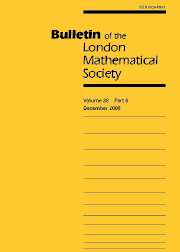No CrossRef data available.
Article contents
WILFRED HALLIDAY COCKCROFT (1923–1999)
Published online by Cambridge University Press: 08 February 2005
Extract
Wilfred Halliday Cockcroft only became known as such after he was knighted in 1983, for he was always ‘Bill’ to everybody. A large Yorkshireman born and bred, son of a proudly skilled plumber, he moved in 1941 from Keighley Grammar School as an Exhibitioner to Balliol College, Oxford. A year later he was called into the Royal Air Force, to become a technical officer in the Far East. He returned to Oxford in 1946 with a group of talented ex-servicemen, and completed his undergraduate work before becoming a research student under Henry Whitehead. Having married Rhona, he needed a job, and so he joined the staff at Aberdeen University, where he completed his doctorate. His first promotion created a vacancy for me, and I personally found it a great general education to be with him, as well as a great luxury to have another topologist to talk to, at a time when topologists (and indeed, people with a ‘modern’ vocabulary) were rare. He was strongly extrovert, very sociable in Oxford, and got on well with the Aberdeen Professor, E. M. Wright, at a time when relations between junior staff and professors tended to be stiff; his relaxed manner with Henry Whitehead (and indeed everybody else) amazed those of us raised among the conventionally introverted. It was thus that Bill had begun to acquire some of his extensive savoir faire and confidence. Besides research, he was naturally drawn to reflect on the problem of teaching the huge ‘First Ordinary’ class in the (to us) strange traditions of a Scottish university. At that time, G. H. Hardy had been writing about ‘Youth’ in a way that was to damage women and the over-thirties, and this aroused fears in Bill that he might soon be too old for research in mathematics, so it was interesting to hear him make the surprising remark (for 1952), that he would want to encourage ‘old’ lecturers to write good school texts if the Hardyesque social climate was making them feel that their pukka research days were over. (In spite of some splendid examples, writing almost any mathematics book in those days was often regarded as creative death, though not by Hardy.) Bill seemed to be fascinated by textbooks (and listed such reading as one of his recreations); he read texts with ease, and thereby widened his mathematical knowledge, in contrast to Cambridge contemporaries of the time, who were brought up on a higher standard of lecturing that left many of them narrow.
- Type
- Obituary
- Information
- Copyright
- © The London Mathematical Society 2005


